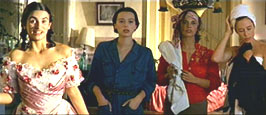
Set in 1931, when a young Spanish soldier decides to desert the army, he winds up arrested by local police officials. Soon enough he is released, and befriended by a lonely local village man, Manolo. Problems arise, however, when Manolo’s four beautiful daughters come to visit their papa, provoking a complicated love tryst that has the soldier confused over which daughter he most loves, since, it seems, he can’t help but love them all.
Director Fernando Trueba’s “Belle Epoque” is a delightful, earthy romantic comedy.
The cast includes: Fernando Fernan Gomez, Jorge Sanz, Maribel Verdu, Ariadna Gil, Miriam Diaz-Aroca, Penelope Cruz, Mary Carmen Ramirez, Michel Galabru, and Gabino Diego.
Tagline: “The film’s humor is based on life’s absurdities, politics, most of all, human nature.”
 The basic story takes place around the time of the Spanish Civil War, telling the adventures of a former seminarian, who is now an army deserter, Fernando (Jorge Sanz), in Spain in 1931. After being taken in by an elderly, lonely artist, Manolo (Fernando Fernan Gomez), who takes a strong liking to young Fernando because of his political views, and friendly personality.
The basic story takes place around the time of the Spanish Civil War, telling the adventures of a former seminarian, who is now an army deserter, Fernando (Jorge Sanz), in Spain in 1931. After being taken in by an elderly, lonely artist, Manolo (Fernando Fernan Gomez), who takes a strong liking to young Fernando because of his political views, and friendly personality.
Then to spice up the plot, Manolo’s four beautiful daughters arrive for a visit. This happens just before Fernando is about to leave Manolo’s villa refuge, and board a train. Fernando, of course winds up staying to get to know these enticing women. Fernando ends up quickly falling in love and having romances with all four of the man’s pretty daughters. Rocio (Maribel Verdu), Violeta (Ariadna Gil), Clara (Miriam Diaz Aroca), and Luz (Penelope Cruz), all cause Fernando to have considerable headaches in this whole process.
To add to the hilarity, is the arrival of Manolo’s opera singing wife, with her manager/lover in tow. Before even entering the villa, she breaks into an operatic aria as she walks up the front steps, to the pleasure of her family. She is a bit of an eccentric, and is dearly loved by both her husband, Manolo, and her long-suffering tour manager.
“Belle Epoque” humorously brings to life a male fantasy: a young man enjoying the pleasures of four different women, which humorously points out what can go wrong in such a situation. That he gets in over his head, so to speak, is to be expected, although all works out for the best in the end.
The film is a future classic because it’s funny, sexy, and offers a fascinating look at life in Spain in the early 1930s, poking fun in a satirical manner of not only human nature, & French bedroom comedies, but the Catholic Church, the Fascists, and the Republicans as well, all historical elements of Spanish politics. The film is crafted like a great work of art, with great performances, excellent writing, and wonderful photography, shot in Portugal.
 My favorite scenes are the young man’s various romantic encounters with the man’s daughters. Each of the sequences are very different than each other, and each keeps us guessing as to which of the four women he’ll end up with at the film’s close.
My favorite scenes are the young man’s various romantic encounters with the man’s daughters. Each of the sequences are very different than each other, and each keeps us guessing as to which of the four women he’ll end up with at the film’s close.
This is a film that seduces the viewer, encouraging you to lose yourself in the film as if in a warm embrace. Its like being single, and young, and traveling back through time to a lusher, riper, more erotic world than our own. Whether such a time actually, in fact, ever existed is not the point. If it didn’t, it should have!
The film won numerous awards in Spain. In addition, it won the Oscar for best Foreign Picture.
If you like “Belle Epoque”, you may enjoy “Tom Jones” and “El Año de las luces.”











































